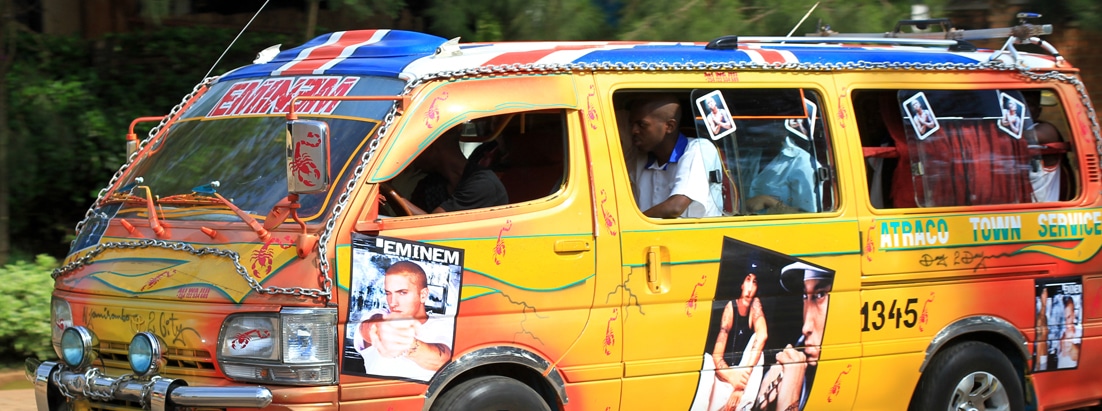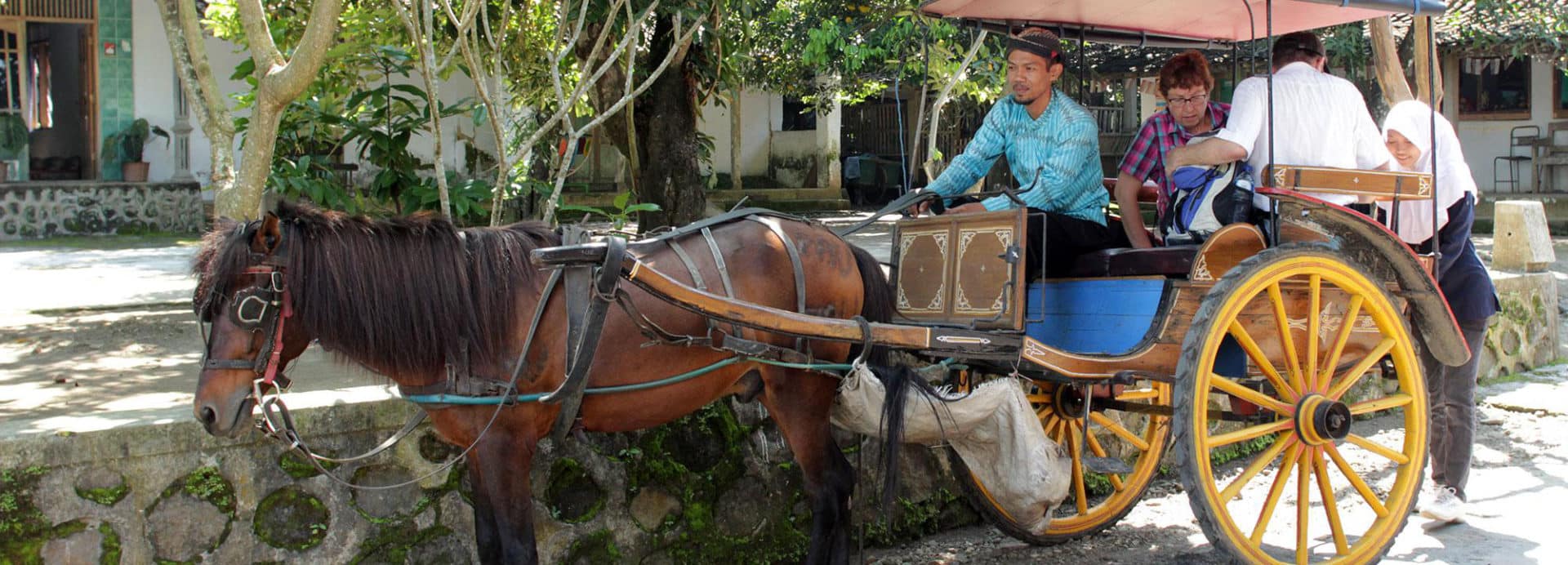All transport modes play a role in Indonesia’s transport system and are generally complementary rather than competitive.
Densely populated Java, with 7 percent of Indonesia’s land area and 62 percent of its population, accounts for 27 percent of the classified road network. At the other end of the spectrum, Maluku and Papua, with 23 percent of the land area and only 2 percent of the population, account for 7 percent of the network.
Railways
Indonesia has four unconnected railway systems, one in Java, and three in Sumatra. The Java railway’s core passenger traffic is intercity with long-distance services, such as Jakarta-Surabaya (820 km), and Jakarta-Yogyakarta (510 km); and medium distance services, such as Jakarta-Bandung (180 km), and Jakarta-Cirebon (200 km).
These trains are quite simply furnished and crowded and dirty, and often run late, but the fares are cheap! Air-conditioned cars are available and female-only cars can be found near the front and end of the trains. E-tickets are recommended unless you want to queue.
Ports and Shipping
Indonesia has some 300 public ports scattered over the archipelago.
The most important ports are Jakarta (Tanjung Priok), Surabaya, Semarang and Cirebon in Java; Belawan, Pandang, and Panjangon in Sumatra; Balikpapan, Banjarmasin, and Samarinda in Kalimantan; Ujung Pandang and Bitung in Sulawesi; Ambon in Maluku; and Sorong in Paua.
Jakarta, Surabaya, Belawan, and Ujung Pandang, the four largest ports, handle most of Indonesia’s export and import cargoes, except for special commodities such as crude oil, logs, timber, rubber, palm oil, and fertilizer which use specialized ports. Much of the domestic traffic originates or is destined to these four ports.
About 14 million passengers a year are traveling by inter-island shipping. In remote islands, a higher percentage of the total number of passengers is traveling by inter-island transport means.
There are two distinct types of inter-island shipping services: ferry, and shipping services. Ferries are generally point-to-point services offered over a relatively short distance, typically between adjacent islands, and use ro-ro vessels that carry a mix of passengers, cars, and trucks. Whereas, shipping services are offered on more complex routes, commonly use lift-on lift-off vessels, and are mostly dedicated cargo services.
Air Transport
Air transport is rapidly increasing. In Indonesia, there are 22 commercial scheduled airlines that carry more than 30 passengers, and 32 commercial scheduled airlines that transport 30 or fewer passengers, as well as chartered airlines.
Some notable Indonesian airlines, among others, include:
- Garuda Indonesia, the government-owned flag carrier of Indonesia.
- Citilink, the low-cost carrier subsidiary of Garuda Indonesia group.
- Lion Air, currently the largest private low-cost carrier airline in Indonesia.
- Batik Air, the premium subsidiary of Lion Air group.
- Wings Air, the regional short-haul subsidiary of Lion Air group, connecting towns and small regional airports.
- Sriwijaya Air, currently the largest medium service carrier in Indonesia, also the country’s third largest carrier.
- NAM Air, a regional short-haul subsidiary of Sriwijaya Air, also using “Medium Service” concept.
- Indonesia AirAsia, the Indonesian branch of Malaysian-based AirAsia.
- Indonesia AirAsia X, the Indonesian branch of Malaysian-based AirAsia X.
- Express Air, a medium service airline. Mostly serving cities in eastern and central Indonesia, but also have several routes in western Indonesia.
- Kalstar, a medium service regional airline serving towns and small regional airports with small aircraft. Mainly serving Kalimantan(Indonesian Borneo).
- Trigana Air, a medium service regional airline serving towns and small regional airports with small aircraft. Mainly serving eastern and central Indonesia.
- TransNusa Air Services, a medium service regional airline serving towns and small regional airports with small aircraft. Mainly serving Nusa Tenggara routes.
- Susi Air, a regional airline serving towns and small regional airports with small aircraft. Started as a chartered cargo airline carrying fresh seafood from Pangandaran to Jakarta, owned by Susi Pudjiastuti.
Jakarta’s Soekarno–Hatta International Airport serves as the country’s main air transportation hub as well as the nation’s busiest. In October 2015, the airport is named as Asia’s largest mega-hub and ranked the 17th most-connected airport in the world.
Next, to Soekarno-Hatta, the top five busiest airports in Indonesia which serve as the nation’s regional hubs are Juanda (Surabaya), Ngurah Rai (Bali), Sultan Hasanuddin (Makassar), and Kuala Namu (Medan).
Island transport
A wide variety of vehicles is used for transportation on Indonesia’s roads.
Taxi
Taxis can be found in pangkalan (taxi queues) at malls and hotels or flagged down off the street with a wave of your hand.
Alternatively, you can phone the taxi company and they’ll send a taxi to your home. There is often a minimum charge for taxis ordered by phone. Depending on where you live and the time of day, ordering by phone may not be as quick as flagging one down off the street. But if you are willing to wait, you can be assured of getting a taxi from a reputable company.
There are several reputable taxi companies, ones you can be sure offer good service and safer drivers. These include Silver Bird, Blue Bird, Eksekutif, Transtaxi, Express, Taxiku,Steady Safe, Kosti Jaya and others. Today, taxi – apps are taking over – Uber, Grab and Go-Jek , which can be ordered online and paid by credit card. Try out the GrabTaxi app to order a taxi easily from a variety of companies.
At ‘flag fall’ the meter begins at Rp 6,500 and climbs Rp 3,500 each 1/10 of a kilometer; the ‘waiting’ rate is Rp 42,000/hour (April 2016)*. It increases at a slower rate for passing time, especially noticeable when you’re stuck in a traffic jam. Most taxi drivers struggle to meet their daily setoran (rent). Especially with all the taxi companies putting new cars on the street, this is an ever more difficult task for the drivers.
Occasionally taxi drivers ask you to pay a set amount for the trip, borongan, instead of using the meter. You don’t have to do this. If they insist, just get out and find another taxi. By doing this, the driver is able to cheat his employer out of a share of his day’s income, because it doesn’t show up on the meter reading.
Other complication may occur when cabbies will try to talk to you and test you to see how much Bahasa Indonesia you know. You’ll hear them say something like … “Sudah bisa bahasa Indonesia, Mister? Mister sudah lama di Indonesia, yach?” He’s actually testing you to see how long you’ve been here, and if you haven’t been here very long, he could drive you around in circles before getting to your destination. Remember – the further the ride – the higher the meter goes! It seems like he’s being friendly and making conversation, but watch out. Make sure you know the most direct way to your destination and then you tell the driver which way to go. Be aware however that there may be a longer faster way, or a “short cut” so if you are suspicious in the driver’s route choice, ask him where and why he is going that way.
Bus
There are a large number of bus companies (bis) servicing routes in Indonesia. Many of the larger buses seat 25-40 people. The buses have set prices (which should be posted on the bus). The air-conditioned buses are more expensive.
The government-owned DAMRI bus company serves the airport on some main islands (Java, Balim Lombok, etc.) It can drop passengers off along the way when off the toll roads. Schedule and rates for DAMRI in Jakarta can be found here. The buses are safe, air-conditioned and comfortable.
All public buses have set routes and set fares, but not all have set schedules. If you’re not sure of the fare, ask other passengers what it is. Pay the “conductor”, who is usually hanging out the back door. He won’t have change for big bills.
Buses are the most common transport of the masses and many are generally in poor condition. Bus passengers are often the target for pickpockets, street singers, small mobile vendors, and beggars – both on the buses and in the major bus terminals. Many bus drivers are notoriously dangerous as they race against each other to try and pick up passengers before the other buses plying the same route. Metro Mini has the worst reputation for poor drivers.
Expat women should take particular care when riding a public bus as uncomfortable occurrences do happen when male passengers grope, rub or lean into your personal space. The Transjakarta buses have a female-only section in the front of each bus, attesting to the common occurrences!
Off the major thoroughfares, buses do not necessarily stop at bus stops; they stop wherever they can pick up a passenger be it in the middle of the road or at a busy intersection. Buses do not necessarily come to a complete stop for passengers to get off and on. So be careful when you step off the bus!
The beginning and endpoints of each bus route are found on the front and back of each bus, along with a route number. If you don’t know which bus to take, just ask the people at the bus stop and they’ll tell you.
Minibus
Public minibusses are used for local transport around cities and towns, short intercity runs and the furthest reaches of the transport network.
Minibusses are known as bemos or angkot, although they are called taksi in many parts of Papua, Kalimantan and East Java. Other names include opelet, mikrolet, angkudes and pete-pete.
Most minibusses operate a standard route, picking up and dropping off people and goods anywhere along the way.
Minibus drivers may try to overcharge foreigners and ask you for triple the normal fare. It’s best to ask somebody, such as your hotel staff, about the harga biasa (normal price); otherwise, see what the other passengers are paying and offer the correct fare.
Drivers wait until their vehicles are crammed to capacity before moving, or they may go keliling – driving endlessly around town looking for a full complement of passengers. Conditions can be extremely cramped, especially if you have luggage.
Ojek “motorcycle taxis”
Ojek service began as grassroots entrepreneurs saw an opportunity to provide transportation options from main roads into housing complexes.
By law, all motorcycle passengers should wear helmets, so ojek drivers should have a spare for you to wear. Ojek tends to congregate at intersections on main roads and near smaller roads that are not serviced by bus routes.
Bargain before you get on – ask a local what the price should be first. Payment is in cash and the drivers won’t have change for larger bills.
Companies such as are Go-Jek, Grab Bike and Yellow Bike have developed an organized Ojek network that allows you to order an Ojek from your phone.
Go-jek (www.go-jek.com) is an Uber-style service where you can order an ojek using a smartphone app at a fair price. It operates in major cities and can be ordered to transport yourself, pick up a meal from a restaurant or deliver goods and documents. Their computerized system uses transparent pricing which reduces the uncertainty of the costs involved! Many people are using these services as transportation time is greatly reduced.
Becak
These are three-wheeled carts either peddle- or motor-powered. The becak is now banned from the main streets of some large cities, but you’ll still see them swarming the back streets, moving anyone and anything.
Negotiate your fare before you get in; and if there are two passengers, make sure that it covers both people, otherwise you’ll be in for an argument when you get to your destination. Becak drivers are hard bargainers but they will usually settle on a reasonable fare, around 2000Rp to 5000Rp per kilometer.
Dokar
A dokar is the jingling, horse-drawn, two-wheeled cart found throughout the archipelago including tourist areas. A typical dokar (or cidomo as it’s known in some areas such as the Gilis) has bench seating on either side, which can comfortably fit three or four people.
Given that many horses and ponies are mistreated, we can’t recommend dokars.
To conclude, all these different methods of transportation are crucial for the distribution of goods, resources, people and tourism, which form an important element in the country’s economy. Speaking of economy, Indonesia’s strategic location makes it an economic powerhouse in Southeast Asia and will continue to improve its transportation infrastructure.
With that said, for those wanting to explore the wonders of the Indonesian archipelago can book a liveaboard cruise with Calico Jack Charter. We offer liveaboard diving trips to some of the most notable diving destinations in Indonesia, such as Cenderwasih Bay Liveaboard, Triton Bay Liveaboard, Banda Sea Liveaboard and Raja Ampat Liveaboard.







